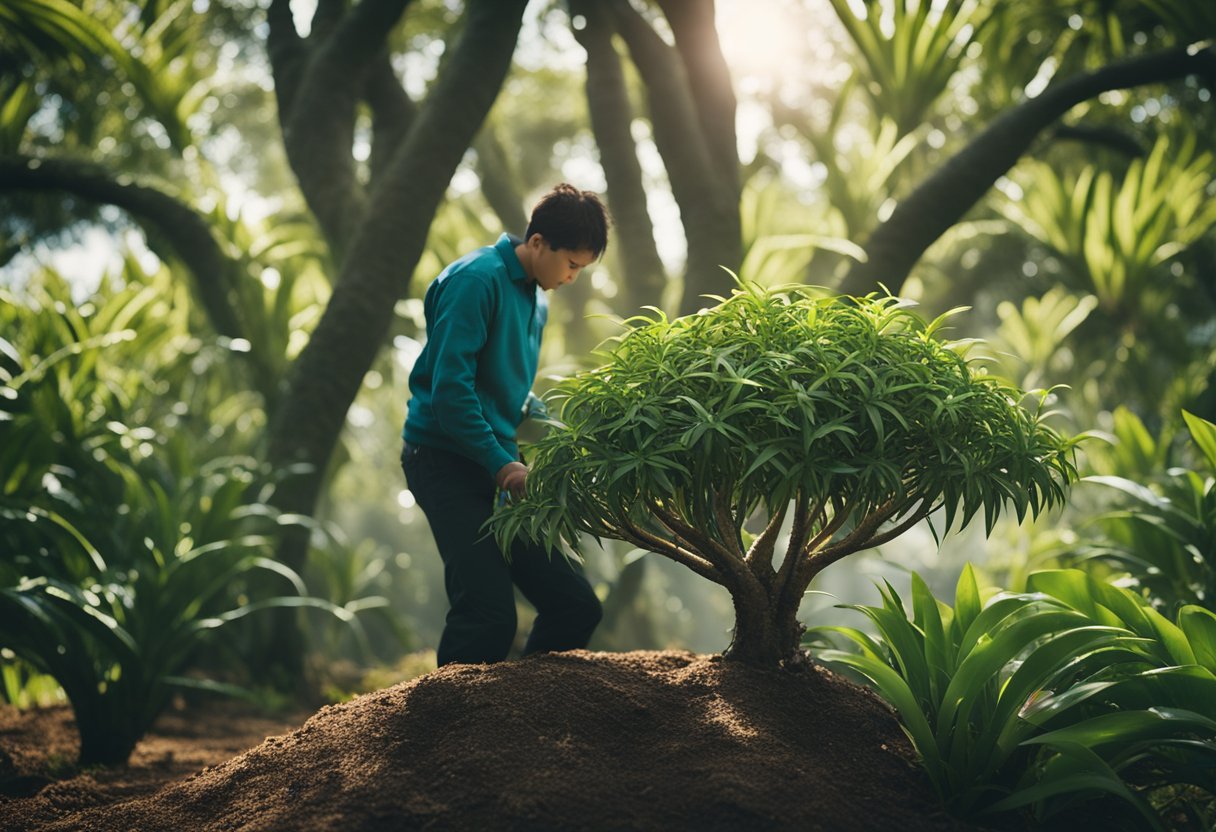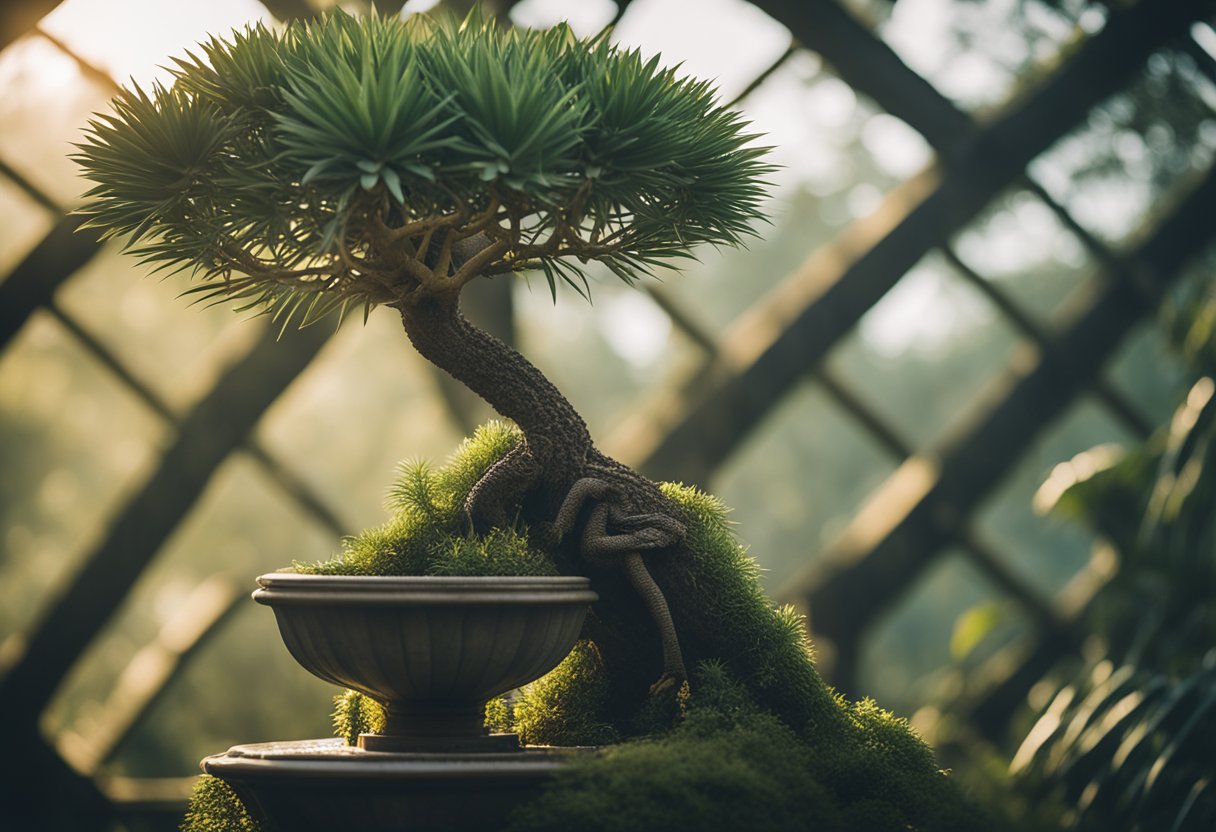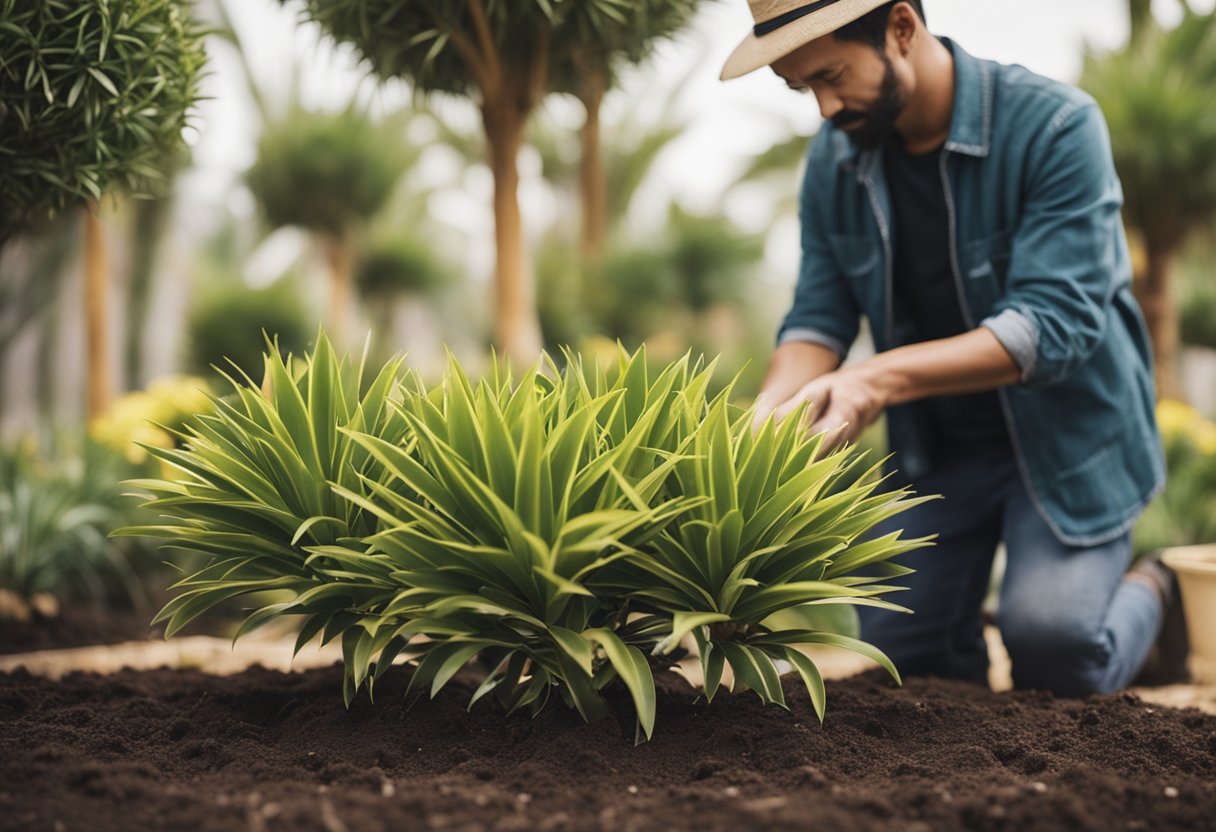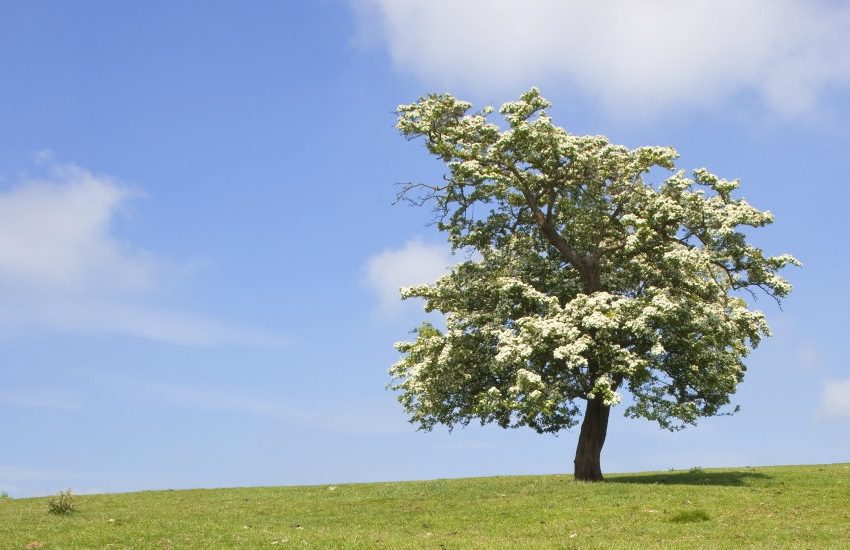Care for a Dragon Tree: Tips and Tricks for Healthy Growth
The dragon tree, also known as dracaena marginata or dracaena draco, is a popular indoor plant that is prized for its unique appearance and easy-to-care-for nature. With its long, slender leaves and striking red-edged foliage, the dragon tree is a great addition to any home or office. However, like all plants, it requires a certain amount of care and attention to thrive.

To care for a dragon tree, it is important to provide it with the right growing conditions. This includes placing it in a bright, but indirect, light and keeping the soil moist but not waterlogged. Dragon trees also benefit from being fertilized every few months and having their leaves wiped down with a damp cloth to remove dust and debris.
Whether you are a seasoned plant enthusiast or just starting out, the dragon tree is a great choice for anyone looking for a low-maintenance indoor plant. With a little bit of care and attention, this striking houseplant can thrive for years to come.
Understanding Dragon Trees
Species Overview
Dragon trees (Dracaena spp.) are a genus of plants that are native to Madagascar, Africa, and parts of Asia. They are known for their striking foliage and are popular houseplants due to their ease of care and ability to purify the air. The most common species of dragon tree is the Madagascar dragon tree (Dracaena marginata), which is characterized by its spiky leaves and thin stems.
Natural Habitat
In their natural habitat, dragon trees can be found growing in a range of environments, from rainforests to arid regions. They are drought-tolerant and can survive in full sun or partial shade. The Madagascar dragon tree, for example, grows in the dry, deciduous forests of Madagascar.
Distinctive Features
Dragon trees are known for their unique appearance, with long, narrow leaves that can be green, red, or variegated. The leaves of the Madagascar dragon tree have red edges, while the corn plant (Dracaena fragrans) has wider leaves that are solid green. The colorama and tricolor varieties of dragon tree have leaves with a mix of green, white, and pink. Dragon trees also produce white flowers and fruits.
Overall, dragon trees are easy to care for and make great houseplants. They prefer bright, indirect light and well-draining soil. Water them when the soil is dry to the touch, but be careful not to overwater as this can cause root rot. With proper care, dragon trees can live for many years and add a touch of tropical beauty to any space.
Planting and Potting
Soil Requirements
The dragon tree is a hardy plant that can tolerate a wide range of soil types, but it does best in a well-draining, loamy soil. The soil should be slightly acidic, with a pH of around 6.0 to 6.5. It is important to avoid using heavy clay soils, as these can cause poor drainage and lead to root rot.
When repotting your dragon tree, it is important to use a good quality potting mix that is specifically formulated for indoor plants. A mix that contains a blend of peat moss, perlite, and vermiculite is ideal, as it provides good drainage and aeration for the roots.
Choosing the Right Pot
When selecting a pot for your dragon tree, it is important to choose one that is the right size. The pot should be large enough to accommodate the plant’s root system, but not so large that it holds too much water, which can lead to root rot.
It is also important to choose a pot with good drainage. A pot with drainage holes in the bottom is ideal, as it allows excess water to drain away from the roots. If you are using a decorative pot without drainage holes, you can place a layer of lava rock or gravel in the bottom of the pot to help improve drainage.
Overall, proper planting and potting are essential for the health and growth of your dragon tree. By using the right soil and pot, and ensuring good drainage, you can help your plant thrive for years to come.
Light and Temperature

Light Needs
Dragon trees are indoor plants that require bright indirect light to thrive. They can tolerate direct sunlight for short periods, but prolonged exposure can cause leaf burn. If the dragon tree is not receiving enough light, the leaves will become pale and lose their vibrant color. On the other hand, if the plant is receiving too much light, the leaves may turn yellow or brown.
To ensure that the dragon tree receives the right amount of light, it is recommended to place it near a window that receives bright, indirect light. If the plant is not receiving enough light, artificial lighting can be used to supplement natural light.
Optimal Temperature
Dragon trees prefer temperatures between 65-75°F (18-24°C) during the day and 50-55°F (10-13°C) at night. They can tolerate temperatures as low as 40°F (4°C) and as high as 90°F (32°C), but prolonged exposure to extreme temperatures can cause damage to the plant.
During the winter months, it is important to keep the dragon tree away from cold drafts and to maintain a consistent temperature to avoid stress on the plant. It is also recommended to mist the leaves occasionally to increase humidity levels and prevent dryness.
Overall, providing the dragon tree with the appropriate amount of light and maintaining optimal temperatures will help ensure its health and longevity.
Watering and Humidity

Watering Schedule
Dragon trees require consistent watering to thrive. Overwatering can lead to root rot and other issues, while underwatering can cause the plant to dry out and die. It is recommended to water the dragon tree thoroughly and then allow the soil to dry out between waterings.
A good rule of thumb is to water the plant once a week, but this may vary depending on the environment and the size of the pot. It is important to use non-fluoridated water as fluoride can be harmful to the plant. To ensure proper watering, a moisture meter can be used to check the soil moisture level.
Humidity Preferences
Dragon trees prefer moderate to high humidity levels. Low humidity can cause the leaves to dry out and turn brown. Misting the leaves with water can help increase humidity levels, but it is important not to overdo it as too much moisture can lead to fungal growth.
To maintain proper humidity levels, it is recommended to keep the dragon tree in a well-ventilated area and away from any sources of dry air such as heating vents or air conditioners. Placing a tray of water near the plant can also help increase humidity levels.
Overall, proper watering and humidity are crucial for the health of a dragon tree. By following these guidelines, the plant can thrive and provide a beautiful addition to any indoor space.
Fertilizing and Pruning

Fertilizer Use
Dragon trees require regular fertilization to maintain their health and vigor. Fertilizers provide essential nutrients that are vital for the growth of the plant. It is recommended to use a balanced fertilizer with an N-P-K ratio of 10-10-10 or 20-20-20. Fertilizers should be applied during the growing season, which is from spring to fall.
When fertilizing, make sure to follow the instructions on the label carefully. Over-fertilization can lead to burning of the roots and foliage, which can cause damage to the plant. It is also important to water the plant thoroughly after fertilizing to ensure that the nutrients are absorbed properly.
Pruning Techniques
Pruning is an important part of dragon tree maintenance. It helps to promote new growth, remove dead or damaged branches, and improve the overall appearance of the plant. Pruning should be done during the dormant season, which is from late fall to early spring.
When pruning, always use sharp and clean tools to prevent damage to the plant. Cut back the branches to the desired length, making sure to cut just above a leaf node. This will encourage new growth to sprout from the node. Remove any dead or diseased branches, as they can harbor pests and diseases that can spread to the rest of the plant.
Regular pruning will help to keep the plant in good shape and prevent it from becoming too large and unwieldy. It is recommended to prune the dragon tree once a year, but more frequent pruning may be necessary if the plant is growing rapidly.
Overall, fertilizing and pruning are essential components of dragon tree maintenance. By following these simple techniques, you can ensure that your plant remains healthy and vibrant for years to come.
Propagation and Growth

Propagation Methods
Dragon trees can be propagated through stem cuttings or seeds. Stem cuttings are the most common method of propagation and are relatively easy to do. To propagate through stem cuttings, select a healthy stem and cut it at a 45-degree angle. Make sure the cutting is at least six inches long and has a few nodes. Dip the cut end in rooting hormone and plant it in well-draining soil. Keep the soil moist and place the cutting in a warm, bright location.
Seeds can also be used to propagate dragon trees, but they require more patience and care. The seeds should be soaked in water for 24 hours before planting them in a well-draining soil mix. Keep the soil moist and place the pot in a warm, bright location. It can take several weeks or even months for the seeds to germinate, so be patient.
Growth Expectations
Dragon trees are slow-growing plants, but they can reach impressive sizes with proper care. They typically grow up to six feet tall indoors, but can grow up to 20 feet tall outdoors in ideal conditions. The growth rate of a dragon tree depends on various factors such as light, temperature, and humidity.
To promote growth, make sure the dragon tree is in a bright location with indirect sunlight. They prefer temperatures between 60-80 degrees Fahrenheit and humidity levels between 50-60%. Keep the soil moist but not waterlogged, as too much water can cause root rot.
In conclusion, propagating and growing a dragon tree requires patience and care. Stem cuttings are the easiest method of propagation, while seeds require more patience. Dragon trees are slow-growing, but can reach impressive sizes with proper care. Keep them in a bright location with indirect sunlight, maintain proper temperature and humidity levels, and keep the soil moist but not waterlogged.
Common Issues and Solutions

Pest Problems
Dragon trees can be susceptible to various pests, including mealybugs, spider mites, scale insects, and thrips. If left untreated, these pests can cause significant damage to the plant. Signs of pest infestation include yellowing leaves, brown spots, and webbing on the plant.
To prevent and control pest problems, regular inspection and cleaning of the plant is necessary. This includes wiping down the leaves with a damp cloth and removing any dead or damaged foliage. In severe cases, insecticidal soap or neem oil can be used to control the infestation.
Disease Management
Root rot is a common problem in dragon trees, especially if they are overwatered or planted in poorly draining soil. Symptoms of root rot include yellow leaves and a mushy, foul-smelling base of the plant.
To prevent root rot, ensure that the plant is planted in well-draining soil and avoid overwatering. If root rot is already present, it is essential to remove the affected roots and repot the plant in fresh soil. In severe cases, a fungicide may be necessary to control the disease.
In conclusion, by identifying and addressing common issues and solutions, dragon tree owners can keep their plants healthy and thriving. Regular inspection, cleaning, and proper care will help prevent and control pest problems and disease management.
Safety and Toxicity

Dragon trees are generally considered safe for humans, but it is important to be aware of potential hazards and toxicity to pets.
Toxicity to Pets
Dragon trees contain saponins, which can cause vomiting and diarrhea if ingested by pets. While the toxicity level is generally low, it is important to keep dragon trees out of reach of pets and to monitor them closely if they are in the same room.
Cats are generally more sensitive to the toxic effects of dragon trees than dogs. If a cat ingests any part of the plant, it may experience gastrointestinal upset, depression, and loss of appetite.
Dogs, on the other hand, may experience mild gastrointestinal symptoms such as vomiting and diarrhea if they ingest the plant. However, the symptoms are usually self-limiting and resolve within a few days.
To prevent accidental ingestion, pet owners should keep dragon trees out of reach of their pets and supervise them closely when they are in the same room. If a pet does ingest any part of the plant, it is important to contact a veterinarian immediately for advice on appropriate treatment.
Caring Tips and Maintenance

Routine Maintenance
Dragon trees are easy to care for and maintain. Regular watering, pruning, and cleaning are essential to keep the plant healthy. The following routine maintenance tips will help keep your dragon tree looking its best:
Watering: Dragon trees prefer well-draining soil and do not like to be overwatered. Water the plant thoroughly when the top inch of soil is dry to the touch. During the winter months, reduce watering to once a month.
Pruning: Regular pruning will help keep the plant in shape and promote healthy growth. Remove any dead or damaged leaves and trim back any overgrown branches. Use clean, sharp pruning shears to avoid damaging the plant.
Cleaning: Dust and debris can accumulate on the leaves, which can interfere with the plant’s ability to absorb sunlight. Wipe the leaves with a damp cloth or sponge to remove any buildup.
Seasonal Care
In addition to routine maintenance, dragon trees require seasonal care to ensure their continued health and vitality. The following seasonal care tips will help keep your plant healthy throughout the year:
Spring: In the spring, fertilize the plant with a balanced, slow-release fertilizer to promote healthy growth. Repot the plant if it has outgrown its current container.
Summer: During the summer months, provide the plant with plenty of sunlight and water. If the plant is kept outdoors, make sure it is protected from direct sunlight and extreme heat.
Fall: In the fall, reduce watering and fertilization to prepare the plant for dormancy. Move the plant indoors if temperatures drop below 50°F.
Winter: During the winter months, reduce watering to once a month and keep the plant away from cold drafts. If the plant is kept indoors, provide it with bright, indirect sunlight.
Frequently Asked Questions
How often should I water my dragon tree to maintain its health?
Dragon trees prefer to be kept on the drier side, so it’s important not to overwater them. A good rule of thumb is to wait until the top inch of soil is dry before watering. Depending on the environment, this could be anywhere from once a week to once every few weeks.
What are the optimal lighting conditions for a dragon tree?
Dragon trees prefer bright, indirect light. They can tolerate some direct sunlight, but too much can scorch their leaves. If the plant isn’t getting enough light, the leaves may become pale or yellow. If it’s getting too much light, the leaves may become brown or crispy.
Can dragon trees be grown outdoors, and if so, what are the best practices?
Dragon trees can be grown outdoors in warm, humid climates. They prefer well-draining soil and partial shade. If you live in a cooler climate, it’s best to keep your dragon tree indoors.
What are the signs of a properly cared for golden dragon tree?
A properly cared for golden dragon tree will have vibrant, glossy leaves and a strong, upright stem. The leaves should be free from discoloration or damage.
Why are my dragon tree leaves drooping and how can I fix it?
Drooping leaves can be a sign of overwatering or underwatering. Check the soil moisture level and adjust your watering schedule accordingly. If the soil is too wet, let it dry out before watering again. If the soil is too dry, water more frequently.
What size pot is ideal for a dragon tree’s root system?
Dragon trees prefer to be slightly root-bound, so it’s best to choose a pot that’s only slightly larger than the root ball. A pot that’s too large can lead to overwatering and root rot.


